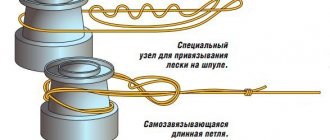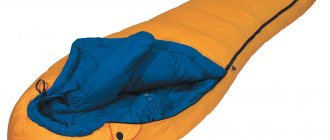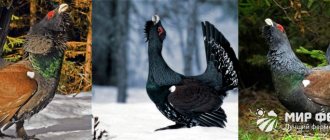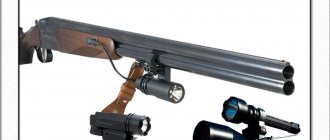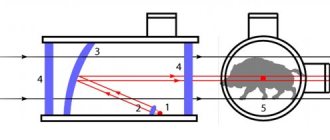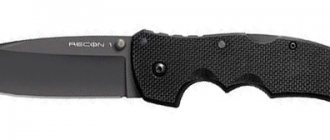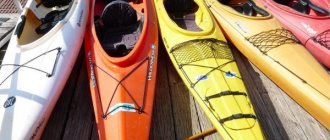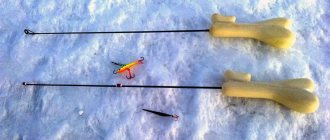Float tackle is one of the winter fishing tools. Fishing with a float in winter can be achieved with varying degrees of success, and the result depends not only on the willingness to sit over the hole for some time, but also on serious preliminary preparation.
Fishing with a float in winter can be successful both in the current and in calm water - the only difference is in the equipment of the fishing rod
Winter float tackle - general information for beginners
The differences between winter float tackle and summer tackle are not only in the size of the rod and the length of the fishing line, but in the shape and weight of the float, the method of loading, the length and location of the leashes and much more. The methods of “working” the rod, the methods of hooking and retrieving prey are also different. Here's how float fishing works in winter in general terms:
- The hook is baited with bait.
- The equipped fishing line is immersed in the water.
- As soon as the sinker touches the bottom, the float is adjusted by moving along the fishing line so that it is immersed in the water 1.5-2 cm from the surface.
- As soon as the fisherman notices even a slight movement of the float, he makes a hook - a sharp, but not strong jerk with the rod.
- Feeling with his hand the resulting load on the tackle, the fisherman begins to slowly pull out the line, bringing the caught fish to the hole.
- Trying not to touch the fishing line over the edges of the hole, the fish is pulled out of the water.
The fishing process can cause certain difficulties, since even a slight touch of a thin fishing line to the edge of the ice can cause it to break and lose the catch.
Float winter fishing rod includes:
- fishing rod (consists of a whip and a handle);
- coil (possibly);
- stand (possibly);
- fishing line;
- sinker and (or) prop;
- leashes (possibly);
- float;
- baited hook or jig.
The leash is included in the gear with a caveat, because there are some fishing methods in which a leash is not used.
Winter fishing rod setup.
Winter fishing rod
The reel and stand are also included with a caveat, because, for example, a “filly” fishing rod has neither a stand nor a reel.
Winter float fishing rod - video lesson for beginners:
Winter fishing rod with float
Unlike the flying version, it is smaller in size, since you have to fish next to the hole, and there is no need for long casts. You can catch bream, crucian carp, perch, and roach with such a fishing rod, but smaller sizes than in summer.
There are three types of float rods:
- With closed coil.
- With open coil.
- Without a reel, when the line is wound on the reel.
There are no strict rules for equipping such a fishing rod; it is similar to a summer fishing rod.
Floats for winter fishing rods
You can choose any color, size, shape of the floats to suit your taste. This does not play a fundamentally important role. The main thing is that while fishing you can see the bite.
There are four types of floats:
- Cone. The name is derived from its shape.
- Cigar. Extended float in the shape of a cigarette.
- Barrel. It is large in size with a cone-shaped top.
- Double float. From the name you can guess that these are two floats attached to each other.
Let's celebrate! In winter, when there is severe frost, so that the float does not freeze along with the hole, they try to submerge it. Even in a submerged position, the bite is still visible.
fishing line
Since the water is clearer in winter than in summer, you should try to choose a thinner line and, if possible, one that matches the color of the water. The visibility of the line can spook the fish. Don't forget about its strength.
Loading
The weight of the sinker must match the weight of the float, sometimes a little more, to sink it, as described above.
The sinker must be attached to the main line, and hooks with bait must be tied with a thinner line to the main line 5-30 cm above the load. The bait should play with the current and not lie on the ground. Therefore, you should experiment with the length of the leash.
Hooks
You can choose any hooks, the most common ones. The main thing is that they do not sink immediately, but keep them playing with the flow while fishing. Instead of hooks, you can use a jig.
There are no restrictions here. Bloodworms, maggots, black bread crust, and burdock larvae are usually used as bait. Accordingly, the size of the hook must correspond to the size of the fish we intend to catch.
How to choose a fishing rod for winter float fishing
The main components of any winter tackle rod are a short flexible whip and a thick handle.
Rings for passing fishing line can be placed on the whip and a nod can be attached. The handle is made of light, non-sinking material. For factory products it is light plastic or cork, for homemade rods it is thick foam or wood.
In some regions of Siberia, birch bark boiled in boiling water is used to make a handle. Under the influence of high temperature, the bark is rolled into a dense roll, from which, after cooling, any object can be cut. The result is a light and dense handle that prevents the tackle from sinking when falling into the water. The difference between fishing rods is the presence or absence of a reel for fishing line.
- "Filly" - this is a design that has two supports located in the front and rear parts of the handle from the bottom, which make the handle look like a sports horse. The supports have a dual purpose - directly as supports and as a place for winding the fishing line during storage. Some types have a protrusion on top, which is also intended for winding fishing line. Often such fishing rods are made with a removable whip.
Fishing filly - «Balalaika“- this design has a whip built directly into the reel body, and it also performs two functions - it serves as a handle and a line storage. It can “work” both with jigs (reelless and with a nozzle) and with floats. The rod can be equipped with rings.
Fishing rod for winter float fishing - balalaika type - Fishing rods with mounted reels. The reels on such fishing rods can be easily removable, and the whips have removable rings. Such solutions allow you to make the fishing rod collapsible and compact.
All of these designs have the ability to attach a nod to the end of the whip, and to pass the fishing line, instead of rings, you can use cambrics.
After choosing a fishing rod, you can begin installing a winter float fishing rod. To do this, you need to select the necessary equipment for it.
How to choose elements of a winter fishing rod
As with any other gear, there are no secondary elements among the components of a winter fishing rod, and when choosing all components, you need to pay attention to their quality and ease of use in the cold season.
When choosing a fishing rod, you need to pay attention to the shape of the handle and the material from which it is made. The handle should fit comfortably in your hand and allow you to swing for a long time. It’s good when it is made of “warm” material: balsa wood, plastic, etc.
The choice of whip stiffness largely depends on the fishing technique used and the type of fish. A softer whip will allow you to perform a smooth game, while a harder one is good in cases where you need to perform a sharp hook. The length of the whip depends on the desired amplitude of the swings. For example, when fishing for bream in winter, sometimes you have to lift the jig high. The optimal length of a winter fishing rod is 30 – 40 cm.
When choosing a coil, special attention is paid to its capacity. It should ensure winding of the required length of fishing line. It is good when the reel is equipped with a brake, which can be released by pressing a lever.
The choice of nod also depends on its rigidity. It plays a role in setting the desired game for the bait. Now the industry produces nods made from a variety of materials. The good ones are those that allow you to change its rigidity by decreasing or increasing the length.
Reels
The equipment of a winter float fishing rod may contain reels of various types for working with fishing line. These can be axial or axial reel-handles for balalaika fishing rods or mounted open inertial or closed inertia-free reels for other types of winter gear.
Learn more about choosing a reel for winter fishing.
Lizard 65 IR - lightweight open reel for float, lure and jig fishing
Selection of fishing line - what to pay attention to?
Fishing lines for winter fishing differ from summer fishing lines in some respects. Thus, the equipment of a winter float fishing rod places serious demands on fishing lines: high strength with a small cross-section; elasticity and, at the same time, acceptable rigidity; lack of "memory".
The main difference between winter fishing line will be the “Winter” marking applied to its packaging. Fishing lines with such markings are usually thin and can break if handled improperly. There are three types of fishing lines used when equipping a winter float fishing rod: monofilament, fluorocarbon and braided.
Monofilament ones for winter fishing are the most popular, easily accessible and at the same time have high strength, good elasticity and rigidity. They can be transparent or colored.
Fluorocarbon. The main advantage of this type of fishing line is its invisibility in the water - the fish does not see such a fishing line. Fishing lines also have a number of disadvantages:
- high rigidity;
- fragility at sharp bends;
- low strength;
- high price.
Due to their high cost, such fishing lines are most often used for making leashes.
Braided lines. Cords have greater strength with a smaller diameter. A small coefficient of stretch makes the tackle more sensitive than when using other types of fishing lines. But at the same time, the lack of stretch can also be a disadvantage, especially when fishing with a short and rigid rod. You can tear the fish’s lip and break the tackle if you make an excessively sharp movement when hooking.
Plus, in the cold, braids freeze, unlike monofilament. For this reason, they are either treated with special means, or preference is given to monofilament fishing line for winter use.
One of the brands of winter fishing line:
As you can see, on the packaging of some fishing lines, the manufacturer even indicates the permissible temperature at which it should be used.
How to tie fishing line to the spool of a reel
Not everyone knows how to do this correctly and efficiently. There are some anglers who generally prefer to ignore any knots and reel in a couple of hundred meters, explaining that they are unlikely to ever cast the bait over such a significant distance anyway. But this method does not justify itself.
This is due to the fact that by the end of the season the length of the fishing line can be greatly reduced due to its breaks, the formation of “beards”, cutting off an area that has become unusable, and so on. As a result, one day she may fly away into the unknown along with an expensive bait tied to her.
It is best to tie the fishing line to the reel spool with a knot that meets these characteristics:
- the knot should be such that it does not prevent the line from freely unwinding from the reel spool at the moment of casting the bait;
- in the event that the line unwinds to the end during a long cast, the knot must withstand and not come undone.
The simplest and most common knot for tying fishing line to the spool spool is the self-tightening one. It has another undeniable advantage - reliability. But that's not all! Such a knot can be stretched under load, and the more often you cast the bait over a long distance until it completely unwinds, the tighter the loop tightens.
How to properly tie fishing line to the reel spool with a self-tightening loop
We tie the fishing line to the spool of the spinning reel in 5 stages:
Anyone can master this method, even those who have never tied a single knot in their life before. It is not only simple and reliable, but also requires very little time, which is especially important when you are on a pond. This knot is suitable for both spinning and float fishing.
Finally, I would like to say that when winding the fishing line onto the spools, you need to stop two to three millimeters from its edge. With this winding, the line will be easier to slide off the spool and fly to its maximum length.
Then you need to make 3-4 turns of the fishing line at the very base of the spool and bring out the tip of the fishing line, as shown in the figure.
In order for the fishing line to be securely held on the spool, you need to make the right knot that cannot come undone. How to do this correctly is described in this article.
[THERE IS AN ANSWER] How to properly equip a float rod for crucian carp
At the initial stage, you need to take the fishing line and make one turn around the spool. In this case, one end should remain of such length that it is convenient for them to knit a knot. If the end is long, it will be awkward to knit, and if it is short, the knot will not work at all.
Then, this end is thrown over the main line, forming a loop.
Then you need to make 3-4 turns of the fishing line at the very base of the spool and bring out the tip of the fishing line, as shown in the figure.
The withdrawn tip is threaded into the formed loop and the tightening of the loop begins. To be safe, it needs to be moistened with water or saliva. If this is not done, the knot will not be so strong. After tightening, you get a reliable and small knot that will never let you down. At the final stage, you need to cut off the protruding end of the fishing line as close to the knot as possible so that the fishing line does not cling to it.
In this way, you can correctly tie the fishing line to the spool. In the picture you can see what it should look like (the knot) after tightening.
If the turns turn out to be crooked, then you should rewind, and if the line runs out, then you need to add a rewind. Its quantity depends on the desire of the fisherman and on the fishing conditions. All actions should be performed carefully, since the material is very thin, durable and well stretched, which means there is a risk of injuring your fingers. Therefore, you need to cover them with a piece of cloth or a thick glove.
How to choose a float for winter fishing: photos of popular options
A float for winter fishing is a separate and truly limitless topic. The industry produces them in a wide variety, but experienced fishermen almost always make winter floats with their own hands. All winter floats can be divided according to the following parameters.
- Fastening on a fishing line - with a fixed attachment point, sliding, quickly replaceable and others.
- Single or compound.
- Float options that change shape when bitten.
Types of winter floats
Let's consider some types of winter floats that have original petal designs.
The “Flower” float is an interesting design for connoisseurs of winter fishing
The flower is made from polystyrene foam with your own hands; it is a float for winter fishing with petals. There can be from 3 to 6. A very sensitive alarm, it will not miss even the most careful bite. Before the bite, it is in a half-folded form, if the bite is “down”, it sinks and folds even more, when the bite is “up”, it floats up, blooming on the surface of the water.
On the left is the “up bite” position, on the right is the “no bite” position.
Float "Tulip" for winter fishing
Its design is similar to the Flower float, but its petals are curved in the other direction and it has a cone-shaped main body. The principle of operation is the same as that of “Flower”.
Made of polystyrene foam.
Float "Chamomile"
The “Chamomile” float is the second name for the “Flower” design.
Float "Butterfly"
The “Butterfly” float also belongs to the petal alarms that open when bitten and is used in winter fishing. Unlike other types, it has only 2 petals.
Like other petal floats, the “butterfly” is made of polystyrene foam.
Separation of floats by parameters
In terms of shape - here the imagination of manufacturers is limitless: barrels, cones, cigar-shaped, with or without an antenna. In principle, the shape of the float does not matter much, the main thing is that it is clearly visible in the water and does not miss a bite. For good visibility in the water, it is painted with bright colors, and for a high-quality response to a bite, it must be properly loaded.
Setting up the loading of a winter float at home in a jar
According to the method of attachment to the fishing line. The floats are non-removable - the fishing line is threaded through a through, vertical hole. It is fixed by inserting a small rod – an antenna – into the same hole.
Non-removable float, with line passing through:
Fastening at one point using cambric. The signaling device is attached using a short rod, which is inserted into a cambric pre-positioned on the fishing line.
Single point mounting:
The fastening is through and removable. The float has a longitudinal (top to bottom) slot into which the fishing line is inserted and clamped with a rod.
Floats are removable, with a slot:
Removable float with slot
Composite. Such alarms may consist of 2 to 3 parts. This design helps to separate the functionality of the float: the lower, larger part is responsible for loading, and the upper, smaller part is responsible for the response to a bite.
The hinged joint allows you to increase the area of the sensitive part - the smaller size of the upper part requires less effort to move. Therefore, this design has greater sensitivity than a single float.
Composite, double float:
The skill of many fishermen is so high that their handmade floats are difficult to distinguish from factory ones. The desire to make floats on your own is also due to the fact that a float for ice fishing made by yourself is easier to load - you can remove the “extra” weight from it even before painting.
You can make a good and sensitive float for winter fishing with your own hands:
How to knit a jig correctly?
There are a large number of technologies for attaching different models of attachments. There is no need to know and use them all. Once you select and try out a few, the fishing enthusiast will use them on many occasions.
Jig with an eye
It is a jig with a ring soldered into the body for knitting a working line.
To tie such a bait, the following methods are used:
- Suspension for the fore-end. Used when you need an angular position of the hook in the water. This position is obtained due to the shifted tension vector of the jig. This fastening is performed using a regular clinch and a self-tightening fishing loop.
- The suspension is straight. This scheme gives a vertical position of the gear in the water. To use this method, special knots are used: palomar, regular or reinforced clinch, hanging in a loop.
Tips for a fisherman: How to make a helicopter tackle for winter fishing - Choosing the best
Mormyshka without an ear
To knit a rewinder with a hole, use the same methods as for the base of a forearm with a ring. In this case, the fishing line is passed into the body of the jig from the sting side and secured with a Canadian (ordinary fishing loop) knot or clinch. Similarly, they knit such rewinders without ears as the devil or the goat.
Tungsten jig
Rewindless products made of hard metals such as tungsten have taken a strong position.
Products made from it are much heavier than their “lead counterparts,” which has a beneficial effect on their scope of application:
But in addition to the advantages, there is also a negative side - tungsten is a hard metal that is difficult to process. The burrs and sharp edges of such a reelless reel injure the fishing line, which means the chance of breaking the monofilament thread and losing not only the jig, but also the removal of the trophy specimen increases.
Methods for fastening tungsten products:
Traditional knitting methods. These techniques are described above. The nuance here is to prevent the line from coming into contact with the metal.
For this, a cambric is used, which is inserted into the hole in the body of the jig:
Making an additional element from a braided cord - an eyelet. This method appeared relatively recently, but has already become very popular. By using it, problems with fishing line injuries are eliminated.
This technique is quite labor-intensive, requiring additional effort and the use of tools (needle, braid, soldering iron).
Method 1
Initially, you need to prepare the braid if it does not fit into the hole in the mothless body.
A braided cord consists of several fibers - they need to be unraveled:
- Cut a piece of braided cord 5 cm long.
- From the side of the sting we pass a thin fishing line and wind it back so that a loop is formed on the back side of the jig.
- We put the prepared piece of braid in half into this loop and bring it back through the hole with the help of a fishing line, so that the loop comes out from the side of the sting. You should get an ear coming out of the hole on the side of the sting.
- The resulting loop from the braided section must be fixed. This can be done using a 1 mm fishing line. We thread it through the resulting eyelet.
- On the other side of the body, we pull the two ends of the cord and wrap them around the shank of the hook several times. One end is clockwise, the other is counterclockwise. Tie with a simple or double knot.
- Instead of cutting off the excess ends, you can fluff them up, then the bait will gain additional attractiveness for fish.
- The main monofilament line is threaded through instead of the thick securing line and tied with any known knot.
Method 2
The only difference in this method is that the ends, pulled into the hole of the rewinder, are not wrapped around the forend. A locking unit is made, which, together with the tips, is melted with a soldering iron, a heated knife or a screwdriver.
The only drawback of this design is the impossibility of recreating it directly while fishing.
Jigs made of hard and soft materials
The technique for tying jigs made of hard and soft materials is the same. The difference is that most purchased products made from hard materials have technological flaws: sharp edges and burrs that are almost impossible to process.
Therefore, in order to tie such a product, it needs to be modified (cambric, braided eyelet). Soft material, such as copper or lead, is more gentle on the monofilament.
To verify this, watch the perches. On the first ice, if you look into the hole, you can clearly see what effect a quick return of the jig to the point of an empty bite gives compared to a slow return. After a long pause, the perch seems to have to “tune in” to the bite again.
Hooking is a very important element of fishing technique. Usually, when the hook is empty, they say: “I hooked it early” or “I was late with the hook.” When the hook is correct, even if it is empty, the jig makes a jump upward of only 40-50 cm and immediately returns to the bite point. Unfortunately, many fishermen perform this technique incorrectly - they “cut” with the movement of the whole hand. The jig moves a meter or more away from the bite point, and while the angler lowers the light tackle again, the fish most often leaves.
To verify this, watch the perches. On the first ice, if you look into the hole, you can clearly see what effect a quick return of the jig to the point of an empty bite gives compared to a slow return. After a long pause, the perch seems to have to “tune in” to the bite again.
How to hook correctly?
Maybe when lifting the tackle, it seems to the fish from the side that the lower jig is chasing the upper one and you need to attack this strange “food object” first. Therefore, most often the upper jig is smaller, and sometimes it is replaced with a regular hook with beads, thread or cambric.
Maybe when lifting the tackle, it seems to the fish from the side that the lower jig is chasing the upper one and you need to attack this strange “food object” first. Therefore, most often the upper jig is smaller, and sometimes it is replaced with a regular hook with beads, thread or cambric.
We will look at several methods so that you can choose which one is suitable for your case.
Important addition. Since the fishing line does not like knots and sharp bends, and usually breaks in such places, it is recommended to check such equipment for strength before each trip. It is better to prepare a winter fishing rod in advance for fishing and tie the equipment with two jigs at home in the warmth, than to later get a break on the long-awaited bream, ruin your mood and waste time installing the tackle on the ice in the cold wind and frost.
- Heat an elastic PVC cambric in boiling water, stretch it to the desired diameter size and pass it through the eye of the jig.
- Fix the casing and release it beyond the edges of the countersunk hole. This way the line will be protected from chafing.
A jig is a small piece of fishing equipment; it is a hook soldered into a piece of metal. It is made from tin, lead, and tungsten.
Tips for a fisherman: Which fishing line to choose for winter fishing - Let's take it step by step
There are two types of jig designs - with and without ears. The steps to attach them to the main line are completely dependent on the design of this part.
Which one to choose?
When choosing a jig, you take into account the depth of the reservoir where you are going to fish, the speed of the water flow in it, and most importantly, what kind of fish you are going to catch.
It is important for a novice fisherman to understand the truth: the greater the depth, the greater the mass of the bait, and also to take advantage of information from the arsenal of experienced fishermen:
- If the depth of the reservoir is no more than two meters, the weight of the jig is 0.3-0.5 g;
- If the depth is four to five meters, the mass of the jig is up to 1.0 g;
- At a depth of seven to eight meters, winter bait should weigh 1.2-1.5 grams.
It’s not enough to buy a jig; you also need to figure out how to tie it to the fishing line, what kind of knot to use to attach it so that it is of high quality and does not come undone. If the knot is knitted incorrectly, it will come apart, and the jig will fly into oblivion, and the fisherman’s mood will be ruined.
The design of the jig determines the method of tying the knot that should be used.
How to securely tie a jig to a winter fishing rod? This question is asked by all novice winter fishermen. Let's figure it out in order.
How to tie a jig without an eye
For a jig that does not have an eye, a simple and popular method among fishermen is used, the procedure is as follows:
- Thread a piece of fishing line into the hole of the jig, the end of the piece should extend beyond the edge of the hole by about 10 cm (the hook points up).
- Form the required loop near the hook.
- Press the hook of the jig with the resulting loop. Wind five turns of fishing line around the hook and loop.
- Insert the end of a piece of fishing line into this loop.
- Tighten the knot after moistening it.
- Remove excess line.
How to tie a jig to a fishing line with an eye
With an eye, a jig can be tied to a fishing line in several ways: Simple Knot, Clinch and Figure Eight. Let's look at each in more detail.
Clinch
For a bait that has an eye, the “Clinch” knot is used.
- Pass the line through the eye of the jig.
- Wrap the main piece of fishing line four or five times, making sure that the very first loop is not tight.
- Thread the end of the fishing line into the loop.
- Moisten the knot and tighten tightly.
- Trim off excess.
A variant of this unit for a winter jig of the “Drop” type:
- Take a jig with a hook, the tip of which points upward, and insert a fishing line into its eye.
- Roll the line into a ring.
- Wrap part of the ring with fishing line and make several turns.
- Pull the resulting winding, i.e. end of the wound fishing line and pull the rest of it to form a figure eight.
- Pass the point of the hook through each ring of the figure eight.
- Moisten the knot and tighten.
These methods of tying jigs are not suitable for tungsten products. This is a hard metal, jigs made from it (even very high-quality ones) quickly destroy it in direct contact with the fishing line.
Tungsten jig
There is a way to improve a tungsten jig so that it does not fray the fishing line.
Eight
- Take a jig with a hook, the tip of which points upward, and insert a fishing line into its eye.
- Roll the line into a ring.
- Wrap part of the ring with fishing line and make several turns.
- Pull the resulting winding, i.e. end of the wound fishing line and pull the rest of it to form a figure eight.
- Pass the point of the hook through each ring of the figure eight.
- Moisten the knot and tighten.
These methods of tying jigs are not suitable for tungsten products. This is a hard metal, jigs made from it (even very high-quality ones) quickly destroy it in direct contact with the fishing line.
Tungsten jig
There is a way to improve a tungsten jig so that it does not fray the fishing line.
You need to do the following:
- Heat an elastic PVC cambric in boiling water, stretch it to the desired diameter size and pass it through the eye of the jig.
- Fix the casing and release it beyond the edges of the countersunk hole. This way the line will be protected from chafing.
This problem can be solved in another way. To protect the line from the sharp edges of the tackle, you need to use braid.
To do this, a loop is made from a cord and fishing line, which is threaded into the hole, while the cord should protrude beyond the edges by no more than 1 mm. The cord is attached to the tackle, and the fishing line is attached to the loop made in the form of a knot. The most famous knots for tying tungsten jigs are Palomar, Trailin, Double Clinch.
Loading the float tackle
Loading is the most important element in setting up float gear. It is best to carry out this process warmly, at home or in the winter hut.
Loading the tackle consists of selecting a sinker, or a sinker with an underlay, so that the finished fishing line with full equipment slowly sinks. In fact, loading is the selection of a weight balance between the carrying capacity of the float and the sinker.
The task of the sinker is to deliver the hook with bait to the bottom or to the required depth. The job of the float is to inform the fisherman about a bite. A float that is too powerful and a light sinker will miss the bite. A weak float will sink a heavy sinker so that the fisherman will not see not only the bite, but also the alarm itself.
The loading process goes like this: the largest load is placed just below the float, then a feeder is attached at a distance of 50-70 cm down from it. It may consist of one or several small weight pellets, and the last load should be no closer than 4-5 cm to the hook. Correct loading is the condition of the tackle when it slowly sinks and the float hangs 1.5-2 cm from the surface of the water.
Loading option
Possible options
To attach the fishing line to the reel, you must have fishing line, any type of reel, wire cutters or scissors. Among the huge variety of methods, there are several methods that have proven to be highly effective and fundamental. It is with practicing these methods that a novice fisherman should start.
Arbor Knot
Reliable way. This method is used to attach fishing line to the spool. It is permissible to use backing. First you need to wrap the line around the reel once. A simple loop is then worked around the main end. Then a knot is tied at the end of the fishing line. Finally, you need to tighten it. The efficiency of use on braided wire is low. Using a node for backing is effective.
Self-tightening loop
One of the most used types of attaching fishing line to a reel due to its ease of manufacture. They are reliable and simply tighten when pulled. The process takes a little time and consists of several stages:
- The line wraps around the spool.
- A loop is made at the free end.
- The base of the loop, the main line, is wrapped with the free end.
- Finally, the free end is threaded through the top of the loop. Then the resulting knot is moistened and tightened. Excess fishing line is cut off with wire cutters.
[THERE IS AN ANSWER] Do-it-yourself winter fishing rod for trolling perch
The main advantage is ease of manufacture and high efficiency of use. To make a loop you don’t need to have a lot of equipment or any skills. Even a novice angler can tie a fishing line to a reel in this way. The tightening force of the knot directly depends on the mass of the load. The greater the weight, the more the noose tightens.
The popularity of the self-tightening loop is due to the fact that there is no likelihood of spontaneous untangling. The loop can only be untied manually.
Silk knot
The second name is “self-tightening figure eight”. A suitable option for attaching fishing line to the spool. The production of a unit includes several stages:
- One turn of the line is made around the reel spool.
- The free end is then wrapped around the main end.
- The two ends obtained are wrapped in a manufactured loop.
- The free end is pulled through the first loop, after which the resulting knot is tightened.
The main requirement for attaching fishing line to the base of the reel is that the knots being made do not have stretchability. If the line is attached to the reel spool, the knot should be located at the bottom of the spool to avoid frequent contact with the line. The knot made should not prevent the line from rewinding during the process of casting bait.
In order to avoid discomfort during long casts, it is worth filling the spool with fishing line 1 - 2 mm below the cut.
The simplest and most common knot for tying fishing line to the spool spool is the self-tightening one. It has another undeniable advantage - reliability. But that's not all! Such a knot can be stretched under load, and the more often you cast the bait over a long distance until it completely unwinds, the tighter the loop tightens.
Hooks
In winter fishing, small hooks are used, because it makes no sense to tie a thick hook on a thin fishing line. Hook options for various baits are summarized in the table.
| Type of bait | Hook number |
| Barley, corn, worm | 12, 11 |
| Maggot, caddisfly | 16 – 12 |
| Bloodworm | 24 – 18 thin, painted in color |
| Dough and other soft baits | 24 – 11 with spring coil |
So that the jig bites
What determines the selection of a winter fishing rod and its equipment?
I have already mentioned some conditions on which the selection of a winter fishing rod for ice fishing in winter depends, and some are probably not so obvious. So, the choice of gear depends on what kind of fish bites (size and type), on the number of empty bites, on the depth, on weather conditions and, finally, on the tasks that the fisherman faces. Let's talk in more detail about each of these aspects.
Fish size. Everything seems to be simple and clear here: a big fish means a thicker line, a larger jig. But this is only if there is a purposeful catching of large fish, which, for example, happens to me quite rarely.
Type of fish. This factor sometimes plays a significant role. After all, for example, a 300-gram roach or humpback perch resists more strongly than a bream of the same size. A half-kilogram bream, and from great depths, can be taken even with the thinnest fishing line ø 0.05 mm. And with “bonuses” of other types, the chances are minimal.
And one more moment. For roach and bream, especially if the fish bites while lowering or “on the stand,” rapid shaking of the jig is absolutely not necessary. This means that there is no need for a thin fishing line (i.e. to ensure the clearest possible contact between the nod and the jig). For example, you can take a fishing rod with a 2.4 mm jig and a line ø 0.08 mm, and successfully catch roach from a depth of 5 m.
In the first round, I guessed the place where the fish stood, and, as it turned out, I drilled holes in the most fishy part of the zone. The roach began to peck, “like a machine gun.” But I’m used to the fact that here in Belarus perch bite from such depths, and, of course, not at such a frantic pace. I fished with fishing lines ø 0.06-0.07 mm and ended up tangling several fishing rods, and also got the jig broken in the working hole itself, after which it “died.”
Tips for fisherman: Ice drill for winter fishing with a screwdriver prices - Features of choice
And this also happens. You come to a well-fed hole, lower the relatively coarse tackle - you catch a few active fish, and that's all. You wind it up, lower the more delicate one - and, lo and behold! - you take out a few more fish that you might think weren’t there...
There is one more technique, which, however, is prohibited in a sports jig, but nothing prevents you from using it for amateur fishing. The point is that half a meter above the jig, one or more small lead “pellets” are clamped onto the fishing line. Thus, we can quickly deliver a small jig to the depths, which the fish will bite on more confidently. For catching perch, such equipment is not particularly relevant, but for white fish, when the bites go down smoothly, it works just fine!
Other factors. Sometimes in strong winds you have to use heavier jigs (even if sacrificing the realization of bites), because otherwise it is generally impossible to recognize the bite - the wind shakes the nod so much that nothing is clear at all. But in this case, I would not recommend increasing the diameter of the fishing line. Of course, a thick line gets tangled less, but it also sails stronger. This means that the effect of increasing the weight of the jig is lost.
The choice of gear also depends to some extent on why we come fishing. If you just want to relax, then maybe there is no point in getting carried away with ultra-thin fishing lines and small jigs. Let us not catch a few capricious fish - sometimes this is not the most important thing. If you are interested in maximum results, then you should use the above tips and fish with harmonious gear.
The handle can be made from any warm material. For this purpose, dense foam or wood are most suitable. This is explained by the fact that these materials are easy to process and it is quite easy to give the future handle the required shape. To increase water resistance, the workpiece is coated with water-repellent varnish or appropriate paint.
Installation and assembly of a winter float fishing rod
After preparing all the components of the equipment, proceed to the installation of the winter float fishing rod:
- We prepare the fishing line - its length is equal to the depth of the reservoir, multiplied by 2, plus 2-3 meters.
- We wind it on a reel.
- We pass it through the rings, put a cambric on it for the float, and another 2-3 cambrics if the whip is without rings.
- We pass it through the float if it is used as a non-removable one.
- We tie a hook or jig.
- We load using a set of shotguns.
Assembly and installation can be considered complete after 2-3 different equipment options have been prepared for the fishing rod. For example, for fishing in still water and for a reservoir with a current.
Differences in reservoirs affect the load and sensitivity of the gear. For still water, use a thinner fishing line with a hook or jig at the end. Fishing in the current requires thicker fishing line and the use of leashes, which means a more powerful float and a heavier load.
Installation of a winter float fishing rod - how to assemble the tackle step by step clearly in the video:
Loading with jig
Loading a winter float with a jig has its own characteristics. To adjust the weight of the bait and the carrying capacity of the float, the same 3-liter jar of water is suitable as when loading equipment with one sinker.
Tips for fisherman: How to catch perch in winter with a jig - Detailed review
When choosing winter jigs, you should take into account their difference in weight. Tungsten products are used for fishing in great depths, and tin baits are successfully used in shallow waters. The best option for a winter float fishing rod is lead jigs with bait.
Correct loading of a winter float is performed in the following sequence:
As a bite alarm for ice fishing, many people prefer to use a nod instead of miniature floats. This is a convenient choice for fishing with a retrieve at different depths from a boat or from ice, in still water or in current conditions. It makes it possible to clearly record the bite signal with a variety of wiring techniques and playing with a jig. This method is used to catch white fish - ruff, pike, perch, bream, silver bream and roach. There are several types of fishing rods suitable for winter fishing.
Tooling errors
No one is immune from mistakes, but the ability to quickly and without losses distinguishes an experienced fisherman from a beginner. The most common mistake in rigging is the incorrect selection of the “float-sinker” pair.
The wrong choice of hook size is trying to “put” a small bait on a large hook. When preparing gear for fishing in the current, you can make a mistake in the length of the leashes and their location on the main line.
A real fisherman will never stop because of a mistake; he will try, experiment, and eventually select the necessary equipment.
Setting up - different types of loading of a winter float fishing rod
Various settings are available for different fishing conditions. Water flow or standing water, a bottom covered with algae or silt, the expected species of fish and many other factors - all this is taken into account when setting up the gear.
Float over water
An option for setting up gear for catching large fish in rivers and other bodies of water with flowing water. When setting up, it is necessary to take into account the weight of the leashes, as well as the water pressure on the tackle. It is possible to use a sliding sinker.
Large, powerful floats and heavy sinkers are used that can keep the tackle from being carried away by the current. Strong, thick main line.
Float underwater
Fishing in still or slow-moving water. It is sunk not only to prevent the float from freezing into the ice, but the main goal is high-quality, precise adjustment of the gear for catching cautious, slow-moving fish.
Equipment options
Two floats
Also intended for fishing in still water. For high-precision tuning for very weak bites. The main float carries the load from the tackle, and the small one is responsible for the bite.
Composite floats
The main task is to catch bottom and demersal species of fish. The ability to respond to both the rise and fall of the bait by the fish, as well as the movement of the bait to the side.
The procedure for assembling a winter fishing rod
1. The required amount of fishing line is wound onto the reel. The length of the fishing line must have a reserve of at least 4 meters, taking into account the depth of the reservoir.
2. The reel is attached to the rod. Often there are samples of fishing rods equipped with reels. This is convenient, but if the reel breaks, you will have to change the rod completely.
3. The whip is tightly inserted into the handle and a nod is attached to its tip. It is convenient to use ready-made devices for installing the nod. This allows you to change its length if necessary or replace it with another model.
4. The fishing line is passed through the nod and a leash is tied to it. It is advisable to use special carabiners and swivels when attaching the leash.
5. The bait must be hooked on a pond. This will prevent the tees from snagging during transportation.
Simple winter fishing rods are not expensive, but many fishermen make winter fishing rods with their own hands.
Main advantages:
Types of equipment
The main rule when equipping a winter fishing rod is the impossibility of creating one, universal tackle for everything. The gear must be different because it works in different conditions.
For fishing at different depths
The best solution when fishing at unfamiliar depths is to use a sliding sinker. In this case, the sinker is attached so that it can slide freely along the main line within certain limits. Thus, by passing the fishing line through the sinker, they adjust the location of the hooks or leashes in depth.
For the current
The main fishing tool in water bodies with weak currents is considered to be a tackle with a diverting leash. At the end of the main fishing line, a load of up to 7 grams is secured in a movable “loop-to-loop” manner. The leash is tied in the same way - the leash moves freely in the loop. This type of fastening helps to change the fishing depth.
For strong and medium currents, use a “herringbone pattern” - 2-3 leashes 15-35 cm long, rigidly attached to the main fishing line. The distance between the fastenings should be 3-5 cm greater than the length of the leashes themselves.
For different fish
The breed of fish intended to be caught is also of great importance. Each breed has its own generic methods of feeding, and therefore the arrangement of gear for catching it is not very similar to others.
The roach is found at medium depths with varying topography. Use a tackle with 2 hooks - one bottom, the second - a leash, located above the bottom.
winter fishing rod rig for roach
Bream can be active at different depths. First, it “tastes” the bait and only then, after a while, swallows it. Catching bream in winter requires very fine tuning of the gear, as well as an instant reaction to the slightest movement of the float.
Crucian carp mainly takes food only from the bottom. For him, the most effective is a bottom fishing rod.
With a nod and a jig
As a bite alarm for ice fishing, many people prefer to use a nod instead of miniature floats. This is a convenient choice for fishing with a retrieve at different depths from a boat or from ice, in still water or in current conditions. It makes it possible to clearly record the bite signal with a variety of wiring techniques and playing with a jig. This method is used to catch white fish - ruff, pike, perch, bream, silver bream and roach. There are several types of fishing rods suitable for winter fishing.
Tips for fisherman: In what winds does the fish not bite in winter - What is the difference, pros and cons
The most popular among fishermen are:
- “Filly” , whose design dispenses with moving elements. Previously, it was placed on legs next to the hole, which is why it got its name. Today it is used without legs. It doesn’t even have a reel: the fishing line is wound around a handle with special grooves. The low weight of the fishing rod increases sensitivity to bites, but the lack of a reel makes this model less comfortable to use.
“Classic” , i.e. a version of a classic rod suitable for jig fishing. It is a handle where the reel and whip are secured. This design requires a special stand in the form of legs for easy placement near the hole. This rod is easy to maintain and suitable for catching sleepy fish, but the increased weight may affect the ease of action of the bait.
Selection of equipment
If you are equipping a fishing rod for the first time, follow the advice of experienced fishermen and pay attention to every significant detail in the design of a winter tool:
Reel or reel. Necessary for adjusting the length of the fishing line to avoid tangles and breaks. When choosing a reel, pay attention to how well it rotates and locks securely, and whether it can prevent the line from spontaneously coming off. Its body must withstand impacts on ice, so make sure that the material is waterproof and frost-resistant. Be careful when using the spool: the closed type does not allow water, snow and ice to get inside and freeze.
Nozzle. It can be different - bloodworms, maggots, worms, bark beetle larvae are suitable, the presence of which should be taken care of in advance. Many people do without them - crucian carp or perch will be attracted even by a red woolen thread or the brightness of the color and shine of the bait. Baitless fishing involves high-precision adjustment of the sensitivity of the nod for uniform high-frequency play with the bait.
Installation
The sensitivity of properly selected gear with a nod and a jig allows you to react to any touch of the bait by a small fish. An unmistakably chosen nod creates an increased vibration frequency of the jig with or without an attachment, which provokes sedentary fish at this time of year to actively attack the tackle. Installing the equipment on a winter fishing rod is not difficult.
To do this, do the following:
Video: Installation of equipment for a winter fishing rod
Drill a hole and clear the surface of the water from small pieces of ice so that nothing interferes with the float.
Fishing with a winter float differs in many ways from fishing with a float rod in the summer.
Drill a hole and clear the surface of the water from small pieces of ice so that nothing interferes with the float.
The float must be loaded with at least two pellets; a small pellet should be placed 5-7 cm from the hook with the nozzle. This will allow the bait to sink slowly, which has a positive effect on the fish’s attention to the bait.
After catching a fish and placing a new bait on the hook, if the old one is missing, lower the tackle into the water again. The line may become slightly frozen with ice when immersing the line - pass it through the clenched fingers of your glove to remove the ice.
Leash. This is a small piece of fishing line that is designed to make the tackle around the hook and bait less noticeable. In addition, the leash serves to protect the line from breaking if there is strong resistance from the fish - it breaks, but the line with the float remains.
A float rod is the most popular fishing tackle that can be used to fish from the shore, from a boat, in shallows and in depth, in currents and in still water. And you can catch almost any fish that lives in our reservoirs. It can be used in all seasons, except when the water is covered with ice.
Let's start with the most important part - the fishing rod. The purpose is to deliver the bait to the right place, hook and pull out the catch. The fishing rod for a float rod should be long enough (from 2.4 m), flexible, durable and light. It's good if it has access rings, but this is not necessary. According to their design, fishing rods are divided into solid, composite - from 2,3 or more legs, which are connected by metal rods.
The color of the fishing line plays a very important role. For daytime fishing you need to take a transparent one, for the night – a dark one. In spring - green, and in autumn - brown. This makes it less noticeable in the water. Depending on the type of fish, the diameter of the fishing line is selected as follows:
- bleak, ruff, crucian carp, perch - 0.15-0.18 mm;
- large crucian carp, asp, bream, small pike perch and carp - 0.2-0.3 mm;
- pike perch, carp, carp – 0.35-0.4 mm;
- silver carp, catfish, other large fish – 0.5-1.0 mm.
Leash. This is a small piece of fishing line that is designed to make the tackle around the hook and bait less noticeable. In addition, the leash serves to protect the line from breaking if there is strong resistance from the fish - it breaks, but the line with the float remains.
Many people tend to use a very thin leash, but one must understand that it must be proportionate to the entire tackle. Select the length depending on the fishing method. It is advisable that the leash be at least the color of the water. For a standard float fishing rod, the most practical would be a leash 18-25 cm long and 0.1 mm thinner than the main line.
Methods for tying two pieces of fishing line
Sinker. The simplest thing is an ordinary lead pellet. You cannot take nuts or nails - they simply tear the tackle when casting. In addition to the round shot, “stalk” and “spindle” weights are also suitable for float fishing rods. But you shouldn’t take it in the form of a drop; they are used on spinning rods.
For catching fry with live bait - No. 1-3.
Small fish - crucian carp, bream, bleak - No. 4-6.
For medium-sized fish: carp, carp, bream, asp - No. 7-10.
For large fish - catfish, pike perch, barbel - No. 10-15.
Knot strength table
The float is the main bite indicator and holds the hook with the nozzle at the desired depth for the fisherman. There are several types of floats and each has its own function.
Floats for 2-3.5-meter rods intended for catching small fish at a short distance from the shore should be light and small. In this case, the fishing line is tightly attached to the rod.
To catch small fish in reservoirs with weak currents, in lakes: crucian carp, perch, roach, tench, bream, it is best to take thin and long floats with a thickened lower or upper part. The tackle can be either a blind rod or a fishing rod with a reel.
Tips for fisherman: What kind of grain can be fed to birds in the feeder in winter - Features of choice
Floats for use in currents where there are constant whirlpools and currents. The optimal shape is a float in the form of a barrel, since it is difficult to lay it on its side or be blown around by the wind. Their large diameter and short length prevent such a float from sinking in whirlpools.
For long casts, you should take heavy sliding floats, which must be secured with a locking knot. These floats allow you to cast bait 20 meters or more from the shore.
But the heaviest barrel floats, very massive ones, should be taken for fishing with live bait. It has several functions - to hold the live bait in the right place, preventing it from moving to the side. But also not to frighten the predator - that is, the lower part should not be massive and very mobile even with sudden movements of the live bait.
A float rod is the first tackle of most anglers, and many, even with the coolest spinning rods, still find time to sit by the water, or even catch a real trophy specimen.
Did you like the article? Subscribe to the channel to stay up to date with the most interesting materials
The general scheme for attaching a float to a fishing rod looks like this:
Bait for fishing with float tackle
Bait is almost always needed. However, it is very easy to overdo it on winter fishing; the goal is to attract fish, not feed them. You need to use complementary foods in advance so that the smell from it spreads throughout the pond. The standard size of complementary foods is considered to be a volume equal to the size of the clenched fist of an adult man. The time from immersion of complementary food to the start of fishing is 15-20 minutes.
Bait is an important point in winter float fishing, but it is important not to overdo it
Winter fishing tactics
The basis of winter fishing tactics is constant experimentation and finding those components when the bite is more or less confident: you need to experiment with bait, equipment, and fishing location.
An important rule is to install as many fishing rods as you can keep track of. The fish does not take to the baited place - try in another place, and then come back. Fish is a slow “comrade” and does not like haste. Doesn’t take bait from the bottom - try raising the bait, switch to a leader rig. There are many options, you need to constantly try them - simply sitting over the hole can leave you without a catch.
In conclusion, we can say that no article, even the most practical one, will teach you how to fish better than even one outing on the ice. Communicate with experienced fishermen, watch their habits, think, experiment and luck will be on your side.
